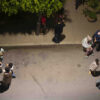A cemetery worker opens a used tomb to place the body of a boy who was found in a collapsed building in Les Cayes, Haiti, Tuesday, Aug. 17, 2021, three days after a 7.2 magnitude earthquake hit. According to an engineer working for Les Cayes Mayor, the boy’s body was found Monday amid the rubble of a collapsed hostal. (AP Photo/Matias Delacroix)
LES CAYES, Haiti (AP) — Haiti’s unusually close relationship between the living and the dead has helped hide, in part, the huge toll of Saturday’s earthquake: People in Haiti want to be close to their deceased relatives, to the point of sometimes burying them in their front yards.
Haiti’s Civil Protection Agency puts the number of dead from the quake at almost 2,200. Questions had arisen about how such a large number of dead could have been handled or buried so quickly, but amateur burials and overflowing private funeral parlors may explain where all the bodies went.
The magnitude 7.2 earthquake injured more than 12,000 people, destroyed or damaged more than 100,000 homes and left about 30,000 families homeless, officials said. Schools, offices and churches — and even funeral homes and cemeteries — were demolished or badly damaged.
https://interactives.ap.org/embeds/8RUfN/5/
The quake also brought the living and the dead even closer in a nation which, like Mexico, celebrates a Day of the Dead holiday: In the countryside outside the city of Les Cayes, some of the frontyard burial crypts were broken open by the force of the quake, exposing coffins inside.
And some of the living came closer to the grave than anyone should: Serge Chery, the head of civil defense for the Southern Province, which covers Les Cayes, said that his officers had found two women buried in the rubble of a two-story apartment building because they had been able to communicate with the outside world via cellphones.
Such stories are common rumors in disaster zones. Chery said his department received innumerable false reports of such calls. “We dialed one number that people said was sending messages from a collapsed house, and a living person answered it in Jeremie,” a nearby city.
But Chery refused to call the real cellphone rescue a miracle.
“The only miracle was that they had their phones charged and in their hands at the time of the quake, and they had sufficient room to dial afterward,” Chery said.
Government hospital morgues, like the one at the Les Cayes’ general hospital, are almost empty. That’s because, as the hospital’s director admits, they haven’t had working refrigeration at the morgue for at least three months due to problems with the electrical equipment.
Instead, local residents know they have to take deceased to one of the dozens of small, modest private funeral homes in the area.
There, at least air-conditioned rooms mean the bodies won’t decompose while relatives struggle to come up with enough money to meet burial costs that can run around $500, a fortune for people in the hemisphere’s poorest country.
Jean Eddy Montezima runs one such parlor, the St. Jaques funeral home in Les Cayes, on a shoestring, and he is overworked and fed up. As he spoke with journalists, another rickety, informal “ambulance” — actually just an SUV with a folding stretcher in the back — pulled up with another body, a woman who died of natural causes at a local hospital.
That’s good, because Montezima says he is no longer accepting the bodies of quake victims. He has 15 corpses crowding his small, air-conditioned rooms. The woman’s body was carried into the parlor and relatives promised to come back later to make arrangements.
Montezima says he has taken in the bodies of at least 50 quake victims since Saturday at his small building, where a noisy generator growls 24 hours a day to keep air conditioners running so the bodies won’t decompose.
“A lot of people may not have the money to bury them,” Montezima said. “If the families don’t come back, I will probably have to do a mass grave with them.” Such a solution is little short of a sacrilege in Haiti, but the beleaguered funeral home director has little choice.
“I was already working eight hours a day, and now I have to work 24,” he said. “I am burning $50 in gas every day. We need an institution or a charity to donate to help with the costs.”
“In some cases, the bodies were in such bad condition, we had to bury them immediately,” he said, adding he can’t hand that task off to the government. “If the body is badly decomposed, they won’t accept them at the morgue.”
Eventually, though, the dead and the living have to part ways.
Chery has the painful task of deciding, along with other authorities, when to send in heavy machinery to clear the rubble, though he acknowledges it will ’inevitably” result in churning up more bodies. Chery said that in the Les Cayes area alone, 300 people are still missing; many are probably still under tons of broken concrete and brick.
“We are planning a meeting to start clearing all of the sites that were destroyed because that will give the owner of that site at least the chance to build something temporary, out of wood, to live on that site,” Chery said, noting that “it will be easier to distribute aid if people are living at their addresses, rather than in a tent.”
He stressed the need to start engineering inspections of buildings to find out which are safe. “If we want the schools and banks and hotels to start working, we have to give people confidence, because they don’t want to go back into those buildings now,” Chery said.
“In Haiti, it is something cultural; families are attached to their dead,” Chery said. “Culturally, even with cholera or COVID-19, people want their relatives to be buried in a nice grave.” But due to the mangled condition of many quake victims, many were buried immediately.
That attitude is on display at the Marc Dor Lebrun funeral home, which he touts as the city’s cleanest and best equipped. Here grieving families can rent a 30-foot-long stretch Humvee limousine to carry the funeral cortege.
Stainless steel refrigerated body cabinets line one room and an air-conditioned preparation room lies nearby. But with the bodies of 17 earthquake victims, and 22 others, already filling his facilities, Lebrun says he cannot take any more.
“It’s because we’re honest. We’re telling people we are not receiving any more bodies,” Lebrun said. “I don’t know about the rest of them,” he said, referring to less well-equipped homes.
“We got three bodies that were so badly destroyed that we put them in zippered body bags and gave them to relatives and they buried them on their own,” Lebrun said.
For the rest — families who can’t meet the costs of burials — Lebrun said he won’t turn them away or set a fixed price. “This is the situation,” he said, referring to Haiti’s grinding poverty. “If a family can’t pay, we’ll help them out.”









































